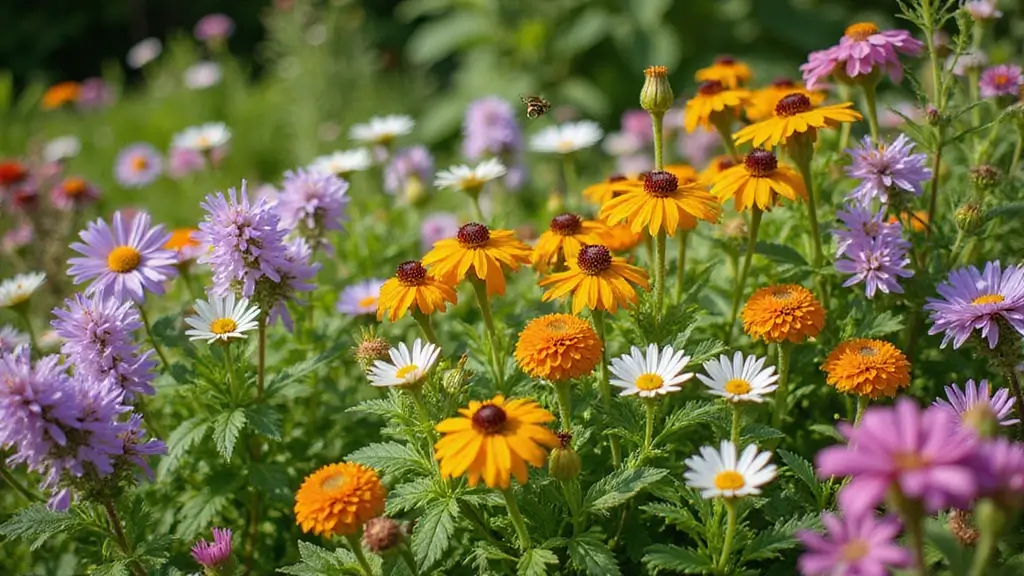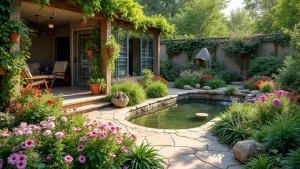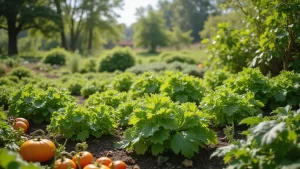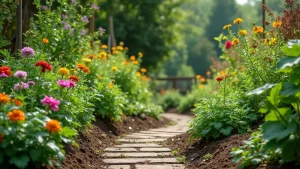10 Stunning Native Plants for Pollinators That Will Transform Your Garden (You Won’t Believe #4!)
Here is why I made this post. I want your garden to thrive and I want to help pollinators find what they need. I kept seeing stressed bees and tired butterflies, and I believe a simple list can help both them and you. Native plants fit our soils and seasons, so they bloom reliably and feed more life.
Who is this for? If you care about local wildlife, easy care, and color through the year, this is for you. You don’t need a big yard or fancy tools. This guide fits small spaces, sunny borders, or even shady corners.
What you will get is practical guidance. Here are 10 native plants that attract bees, butterflies, and birds. They tolerate heat, drought, and busy gardens. You will learn where to plant them, when they bloom, and how to pair them with grasses and mulch. This guide includes simple steps you can try this season.
And yes, you won’t believe number four. It looks simple but draws many pollinators in a small space. It works in sun or light shade and adds color for months.
Next steps are easy. Pick a sunny patch, loosen the soil, and mix in compost. Plant a few natives, water deeply for the first weeks, and mulch to keep roots cool. Watch how bees arrive and how your bed fills with life. This plan fits different styles and budgets, so you can make it your own.
Start small and stay curious. Try one plant this season, then add more next year. You will not only help pollinators you will also enjoy a garden that feels alive. If you want feedback or tips after you plant, drop a comment and I will help you adjust.
1. Coneflower (Echinacea)

If you want a hardy plant that feeds bees and butterflies all season, start with coneflowers. Coneflower has pink to purple petals and a chunky cone center that stands out in any bed. This tough perennial blooms from early summer into fall. It loves full sun and well-drained soil, so it fits in low-maintenance gardens.
Plant where you can enjoy the blooms from a window. Water young plants regularly, then let established clumps dry a bit between drinks. Deadhead spent blooms to spark more flowers and a longer display. If you let a few seed heads stay, goldfinches visit and you’ll hear their cheerful chatter.
Mix varieties for a color chorus: purple, white, pink, yellow, or orange. Plant in tight clumps for bold impact and to give pollinators a bigger feast. In hot summers, a light mulch keeps roots cool and reduces weeds. Divide clumps every 3 to 4 years in spring to keep plants vigorous.
Coneflowers are drought tolerant and relatively pest free once established. They make a sturdy backbone for a pollinator border and a reliable garden feature.
They attract pollinators every morning, building a busy, lively garden. It’s a simple, high-impact addition. Plant a few this season and watch bees arrive.
Transform your garden with coneflowers! These hardy beauties bloom from summer to fall, inviting bees and butterflies to dance among their vibrant petals. A low-maintenance native plant for pollinators that your garden will thank you for!
2. Butterfly Milkweed (Asclepias tuberosa)

Trying to attract more pollinators without a lot of work? Butterfly Milkweed helps. Its bright orange blooms brighten beds and draw butterflies, bees, and hummingbirds. It’s native to many regions, so it fits in most gardens. It grows in sunny spots. It can handle heat.
Here is why it works for you. It loves sun and well-drained soil. Plant it in groups of three or more for impact. Space 18 to 24 inches apart so each shines. Water until the roots settle, then let it go dry between drinks. A light mulch helps roots stay cool. Avoid herbicides and pesticides that hurt your helpers. This plant also tolerates drought and poor soils.
This milkweed is more than a nectar source. It is a host plant for monarch caterpillars, so you may see tiny learners on the leaves. That means a full life cycle right in your yard. The slender green foliage adds a soft texture between the bright flowers.
Next steps: watch for blooms in summer, trim back after flowering to tidy the bed, and divide older clumps every few years to keep plants vigorous. With simple care, you’ll welcome steady pollinator visits and a cheerful, wildlife-friendly scene.
3. Black-eyed Susan (Rudbeckia hirta)

Here is why Black-eyed Susan fits a busy, pollinator-friendly garden. This native plant, Rudbeckia hirta, shows bright gold petals with a dark center. It lights beds from midsummer to fall and stays cheerful.
These sturdy perennials attract bees, butterflies, and even hummingbirds. The blooms come in steady waves, keeping color in your yard when other plants fade.
They crave full sun. Once established, they tolerate dry periods better than many ornamentals. They often self-seed, giving you a repeat show year after year.
To get a natural look, plant them in clusters or mix them with other wildflowers. They look great with tall grasses and can form a loose, meadow-like patch.
Stems are strong, so cut flowers hold well in vases. Birds also gain from the seeds during fall and winter.
Here is how to grow them:
– Choose a sunny spot and give each plant about 12-18 inches of space.
– Water evenly until roots settle, then let the soil dry a bit between drinks.
– Mulch lightly and deadhead after bloom to keep plants tidy.
– Leave some seed heads for birds or to start new plants next year.
Next steps: mark your beds, grab a few plants or some seeds, and begin this pollinator-friendly run.
4. (You Won’t Believe This!) Prairie Dropseed (Sporobolus heterolepis)

You want a garden that feeds pollinators without soaking up all your time. Prairie Dropseed (Sporobolus heterolepis) fits that goal. It’s a grass-like perennial with soft, arching leaves that glow when the sun hits them.
In late summer it sends up tiny, airy flower spikes. They are fragrant and light, and they attract a wide range of bees, butterflies, and other good insects.
This plant does more than look nice. It gives cover and nesting spots for helpful insects. It handles dry spells well, so you save water and keep your garden green longer in hot weather.
Use Prairie Dropseed as an accent along pathways or in borders. Its fine texture adds movement to a scene and blends with other perennials. In fall, the leaves turn a warm golden shade for a nice seasonal signal. The seeds feed birds, bringing more wildlife to your yard.
Getting it started is simple:
– Plant in full sun to light shade in well-drained soil.
– Space plants about 18–24 inches apart.
– Water them until they’re established, then let drought make the call.
– Trim back old growth in late winter to keep tidy.
If you want an easy, wildlife-friendly look, this native grass is a dependable choice.
Transform your garden with Prairie Dropseed – a pollinator’s paradise! With its graceful blooms and nesting spots, it’s the perfect blend of beauty and functionality for your outdoor oasis.
5. Pollinator-friendly Yarrow (Achillea millefolium)

If you want a pollinator-friendly plant that is easy to grow, yarrow fits the bill. Yarrow forms flat-topped clusters of tiny blooms that come in white, yellow, pink, or red. It quickly takes hold as a perennial and draws in bees, butterflies, and even lady beetles. The plant endures drought and poor soil with ease. Its aromatic leaves add texture in the border and act as a natural pest repellent. For a bright display, plant yarrow in groups or mix it with other wildflowers. It also makes sturdy cut flowers that bring a wild charm to your home. Avoid overwatering to keep it thriving. Its bloom lasts from late spring into early fall, keeping the garden buzzing.
Planting and care
– Choose a sunny spot with well-drained soil.
– Space plants about 1 to 2 feet apart.
– Plant in groups of 3 to 5 for a bold show.
– Deadhead faded blooms to extend color.
– In winter, cut back the tops to tidy the bed.
– Water only when the top inch is dry.
Why it helps pollinators
– Bees sip nectar from the flat flower heads.
– Butterflies visit across the long bloom period.
– Ladybugs find shelter and prey nearby when other blooms are around.
Keep pesticides away to let these visitors thrive.
Transform your garden into a pollinator paradise! Planting native yarrow not only attracts bees and butterflies but also thrives in tough conditions. Embrace nature’s beauty while supporting vital pollinators!
6. Joe-Pye Weed (Eutrochium purpureum)

– Overview Here is why you want a tall, pollinator magnet that lasts into late summer.
– Height and bloom It grows 6-8 feet tall and blooms in late summer with big pink or purple clusters that sway in the breeze.
– Pollinator appeal It draws butterflies, moths, and bees when other flowers fade.
– Sun and soil Plant in moist, well-drained soil with sun to partial shade for best growth.
– Garden use Use it as a tall backdrop or natural border in mixed plantings.
– Winter interest After bloom, keep the seed heads for winter texture and birds, which helps through the cold months.
– Moisture loves It loves spots that stay moist, like near ponds or rain gardens.
– Planting steps Here is how to plant: dig a hole wider than the root ball, mix in compost, and water well.
– Care and division It needs little staking; divide every 3-4 years to keep it vigorous.
– Spread caution It can spread by rhizomes in rich soil; you may need to lift extras.
– History Native Americans used it to treat fevers, adding a story to the plant.
– Next steps Next steps: choose a spot, prep soil, plant this season, and watch pollinators arrive and stay.
– Care tip Care tip: cut back after frost to tidy the bed and spark fresh growth.
– Pairing tip Pair it with low, bright companions for a long bloom display from midsummer to frost.
Joe-Pye Weed isn’t just a tall beauty; it’s a late-summer haven for butterflies, bees, and moths! Transform your garden into a pollinator paradise and watch the magic unfold!
| Plant Name | Description | Cost | Care Tips |
|---|---|---|---|
| Coneflower (Echinacea) | Hardy plant with pink to purple petals, attracts bees and butterflies. | $9.99 | Water regularly, deadhead spent blooms. |
| Butterfly Milkweed (Asclepias tuberosa) | Bright orange blooms that attract butterflies, bees, and hummingbirds. | $28.99 | Plant in groups, water until established. |
| Black-eyed Susan (Rudbeckia hirta) | Bright gold petals with a dark center, blooms from midsummer to fall. | $5.99 | Water evenly, deadhead blooms. |
| Prairie Dropseed (Sporobolus heterolepis) | Grass-like perennial with soft leaves, attracts various pollinators. | $7.97 | Plant in full sun, trim back old growth. |
| Yarrow (Achillea millefolium) | Flat-topped clusters of blooms in various colors, drought tolerant. | $6.99 | Space plants 1-2 feet apart, deadhead to extend blooms. |
| Joe-Pye Weed (Eutrochium purpureum) | Tall plant with pink or purple clusters, attracts butterflies and bees. | $21.97 | Needs moist soil, divide every 3-4 years. |
| Goldenrod (Solidago) | Bright yellow blooms that provide nectar late in the season. | $9.99 | Plant in groups, pinch back after flowering. |
7. Goldenrod (Solidago)

If you want a garden that feeds pollinators late in the season, goldenrod is a smart choice.
Why Goldenrod Helps Pollinators
Solidago offers bright yellow blooms from late summer into autumn.
Bees and butterflies visit for nectar and pollen when many flowers are gone.
Here is how to use it in your yard.
– Loves full sun and will grow in poor soil.
– Plant in groups for a bold fall display.
– Birds eat its seeds after the blooms fade.
– Easy to care for and needs little upkeep.
– Naturalizes well in wildflower patches or along borders.
– Its deep roots help soil structure over time.
Next steps
Choose a sunny bed or border.
Place 3 to 5 plants together for impact.
Water well until roots settle, then mulch.
If spread concerns you, pinch back after flowering.
Common questions
Will goldenrod take over in your garden? It can spread a bit, but regular division and smart borders keep it in check.
Plant goldenrod now and watch your pollinator patch glow in the cooling air. This native Solidago turns late blooms into a busy, buzzing moment for your whole garden.
8. Bee Balm (Monarda didyma)

Bee Balm (Monarda didyma)
You want a garden that feeds pollinators and looks great. Bee Balm helps you do both.
Its flowers are tubular and come in red, pink, or purple. This perennial shines from early summer to fall. Bees, butterflies, and even hummingbirds flock to its nectar.
Bee Balm loves moist, well‑drained soil. It handles full sun to partial shade and adjusts well to different spots in your yard. The leaves smell nice and help keep some pests away.
Think about placing Bee Balm near a seating area. You’ll enjoy watching pollinators float by. Plant it in groups of three to five for a bold show. Mix it with other bright perennials. Cut blossoms make pretty indoor arrangements too.
Care is simple. Keep the soil evenly moist in hot weather. Mulch to hold moisture and suppress weeds. Deadhead after blooming to encourage more flowers. Every couple of years, divide the clumps to keep the plant vigorous.
A nice bonus: people have used Bee Balm in folk remedies to ease colds and upset stomachs. It’s not a substitute for medicine, but it adds history and scent to your garden.
Next steps:
– Plan a bee-friendly border with three to five plants.
– Pair Bee Balm with complementary perennials for color contrast.
– Leave a few cut blooms for vases indoors.
9. Asters (Aster spp.)

Asters: late-summer color for pollinators
Here is why asters fit your plan. They bloom from late summer into fall, when many flowers fade. Their colors blue, purple, pink, and white brighten dull days. They offer rich nectar for bees and migrating butterflies. They also attract helpful insects like ladybugs. For wildlife, their seeds feed birds in winter.
– Plant in sun to partial shade and in well-drained soil.
– Start them where they can spread, spacing 12-18 inches for small kinds and 2-3 feet for tall forms.
– Water regularly while they establish, then give steady moisture without soggy ground.
– Deadhead faded blooms to stretch color into autumn.
– Mulch to protect roots and keep the soil cool.
– Group asters for a bold display or mix them with other late bloomers to extend interest.
– In fall, you can leave some seed heads for birds or cut the stems after frost for a tidy bed next year.
Next steps: pick a sunny spot, loosen the soil, and plant asters this season.
Give them a try and watch pollinators visit as fall blooms rise.
10. Scarlet Sage (Salvia coccinea)

Scarlet Sage for a pollinator bed
You want a garden that feeds pollinators and keeps color all summer. Scarlet Sage (Salvia coccinea) fits that goal. Its bright red, tubular blooms catch the eye and draw hummingbirds. Butterflies come for nectar and stay awhile.
This annual loves full sun and well-drained soil. It can handle a touch of shade, but sun brings the best color. Water when you plant, then let the soil dry a bit between drinks. Deadhead faded flowers to keep blooms coming week after week. With regular care, you’ll see color from mid‑summer to fall.
For a bold look, plant several clumps together to form a red focal point. Space them about 12 to 18 inches apart so air moves and plants don’t crowd. Pair Scarlet Sage with other bright perennials to heighten contrast.
This plant also helps the garden. It attracts ladybugs and other beneficial insects that help with pests. The extra pollinators boost fruit sets on nearby plants too.
Next steps: plan a sunny bed with 3 to 5 Scarlet Sage plants. Mark spots in your garden, group them in threes or fives, and keep a simple weekly watering check.
Give it a try this season.
Conclusion

Transforming your garden into a pollinator paradise is easier than you might think! By incorporating these ten stunning native plants for pollinators, you’re not only enhancing the beauty of your outdoor space but also playing a vital role in supporting local ecosystems. Each of these plants provides essential food and habitat for beneficial insects, ensuring a thriving garden.
So why wait? Start planting today and watch as your garden comes alive with color and buzzing activity. Remember, every little effort counts when it comes to creating a sustainable gardening space. Happy gardening!
Frequently Asked Questions
What Are Some Benefits of Using Native Plants for Pollinators in My Garden?
Using native plants for pollinators offers a multitude of benefits! Not only do they provide essential food and habitat for beneficial insects like bees and butterflies, but they also require less maintenance and are more resilient to local pests and diseases.
By incorporating these plants into your garden, you’re supporting local ecosystems and promoting sustainable gardening practices that help protect our environment!
How Do I Choose the Right Native Plants for My Specific Region?
Choosing the right native plants is as easy as doing a little research! Start by identifying your local climate, soil type, and sunlight conditions. You can consult local gardening centers or native plant societies for recommendations tailored to your area.
Look for plants that flourish in your specific conditions and attract the pollinators you want to support. Remember, selecting native plants ensures they are well-adapted to your region and will thrive with minimal intervention!
Can I Attract More Pollinators by Planting Just One Type of Native Plant?
While planting just one type of native plant can help attract some pollinators, you’ll have much greater success with a diverse selection! A variety of plants will provide food sources for different pollinator species throughout the growing season.
By incorporating a mix of flowers that bloom at different times, you create a continuous source of nectar and pollen, making your garden a true haven for pollinators. Plus, it adds visual interest and beauty to your outdoor space!
What Are Some Easy-to-Grow Native Plants for Beginners?
Great question! If you’re new to gardening and want to support pollinators, consider starting with easy-to-grow native plants like Black-eyed Susan and Yarrow. These plants are hardy, require little maintenance, and are known to attract a variety of beneficial insects.
Other fantastic options include Coneflower and Bee Balm. They not only thrive with minimal care but also add vibrant colors to your garden!
How Can I Maintain a Pollinator-Friendly Garden Throughout the Seasons?
To maintain a pollinator-friendly garden year-round, focus on planting a variety of native plants that bloom across different seasons. This ensures that food sources are available for pollinators as they emerge in spring and continue through late fall.
Additionally, consider leaving some plants standing in winter for shelter and habitat. Avoid using pesticides to create a safe environment for your pollinators. Regularly observe your garden and make adjustments to enhance its biodiversity and health!



